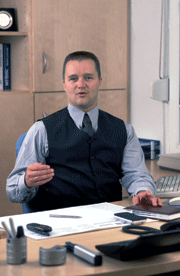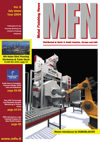E-Archive
MFN Trainer Column
in Vol. 5 - July Issue - Year 2004
Trying to close the Gap

Peter Beckmerhagen
This column is a regular feature and will be written by one of our MFN trainers. Readers are invited to send comments or questions to info@mfn.li. For more information about the trainers, see www.mfn.li link workshops.
by Peter Beckmerhagen, Official MFN Trainer
Many results after mechanical treatment of machine parts can be checked and obtained easily. For example we can check the diameter of a bolt or the length, width and depth of a milled part to name but a few things. The process of measurement is easily accomplished and taught every day.
Completely different requirements are necessary when considering shot peened parts however. For example when examining a part that has been shot peened a layman can readily see that the surface has been uniformly changed and cleaned. Unfortunately a trained shot peen professional will glean little more than a layman through visual inspection alone.
The professional’s trained eye can distinguish whether coverage is less than 100% but anything more conclusive requires a more in depth examination. A conclusive determination of the peening intensity can only be made by means of destructive testing. A residual stress measurement of the part itself or a specially prepared test probe would be necessary.
For this reason when shot peening it is extremely important that the actual shot peening process is properly set up and controlled from the start. Shot velocity, angle of impingement and exposure time are all important parameters to be set at the machine. The control of the peening media is just as important and should take into consideration the size, hardness, shape and density of media used. A saturation curve should be established to insure saturation of parts throughout the peening cycle, and the control of coverage should be maintained as well. Once the peening process has been established, control and repeatability can be achieved through the use of random testing as for example the measuring of Almen Intensity.
So where can one turn in order to learn the proper procedures and intricacies of this complex process? We know that the benefits of shot peening and its uses are all around us. Think about it, each time you enter your car or board a commercial aircraft you do so in complete trust that it was engineered properly and will conduct you safely. That’s due in no small part to the fact that shot peening is widely used to lengthen the service life of security relevant parts used in the manufacture of these modern conveniences. We simply take for granted the fact that the individuals involved in the manufacture of these products have been well trained. However one cannot simply enroll in a shot peening course at a school or university. Until recently it was only possible to learn about the basics of shot peening by working closely with an experienced colleague or through exhaustive literary research. Many of you reading this article can appreciate the fact that it is easier to learn in a group through open dialogue.
For this reason MFN developed a shot peening course in 2002 to help bridge the gap between the layman and scientist. Relaying the basics with regard to the shot peening process, peening media and machine concept is the primary goal of this new training program. Experienced individuals have been recruited from all areas of the peening industry to teach the classes. After a successful series of workshops in Singapore the shot peening course was offered for the first time in Europe in May 2004. This year in Coventry England was the start of an annual workshop that will be hosted yearly in a European country. Next years Workshop will be held in Germany. Though the program was originally developed in the English language, MFN has decided to offer the course in the language of each host country as well. So next year’s workshop will be offered in both English and German, and the training materials have already been prepared. So keep your calendars open and plan to attend the 2nd annual European workshop in May 2005.
Best Regards
Peter Beckmerhagen
Special Note: MFN recognizes the importance of feedback and the role it plays in improving our workshops and the help it offers us in keeping up with current demands. Since the feedback questionnaire was not available at the time of the workshop in Coventry we kindly ask that those who participated take a moment and let us know how we can improve our programs so that we can better meet your needs in future.
Author: Peter Beckmerhagen




























